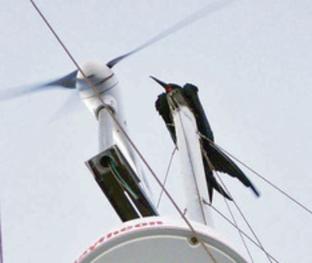Published in the Ocean Watch column, Honolulu Star-Advertiser © Susan Scott
November 28, 2011
My sailboat has a new cylindrical light atop its main mast. This is not your grandmother’s mast light. It’s an energy-efficient, exceptionally bright LED, red on the left side, green on the right and white at the back.
Honu has always had a tricolor light on its masthead to signal the boat’s presence while sailing at night. For some reason, though, the frigate birds here in the Sea of Cortez are absolutely crazy about the new one. During a recent all-night crossing, those rascals arrived periodically in twos and threes to take swipes at the masthead.
 Photo by Susan Scott
Photo by Susan Scott
A male magnificent frigate bird hitches a ride on Honu’s flat-topped mizzenmast.
Because the lights cast eerie shadows and unnatural colors on the big black birds, the sight was breathtaking. And breath-holding. The radio antenna, anemometer and wind vane, instruments I need, are up there, and the birds’ ambitious inspections threatened to break them.
This was no idle worry. At Tern Island in Hawaii’s northwestern chain, I once watched frigate birds attack Honu’s wind-direction device, called a Windex. For days they persisted and one afternoon, splash! Goodbye Windex.
These frigate birds, called magnificent frigate birds, are so similar to Hawaii’s species, called great frigate birds, that I’m hard pressed to tell the difference.
All five frigate bird species in the world have pirate tendencies, stealing fish from airborne tropic birds and booby birds. Frigate birds, however, mostly make an honest living, catching the majority of their fish themselves. The birds’ thieving is famous because it’s such a spectacle to watch.
Sometimes frigate birds attack in twos, threes or more. These aren’t coordinated attacks, like those of wolves or hyenas, and the birds are definitely not into sharing. When a potential meal flies past, and when fish are jumping, frigate birds seem to pop out of a hole in the sky to check it out.
I once saw two frigate birds each grab a leg of a red-footed booby bird in flight and flip the poor thing upside down. The booby threw up its fish in midair. One frigate bird caught it, and the fight for the prize was on.
Frigate birds can neither walk nor swim, but with 8-foot wingspans, can these birds fly. Flapping is minimal. The seabirds work the wind like Olympic sailboat racers, soaring at high altitudes like bird-shaped kites.
My seabird books tell me frigate birds are strictly day birds that return to islands every night, roosting in trees or other high places.
Some individuals, though, are apparently night owls, wheeling around in the dark, causing mischief.
“What are you doing up so late?” I said to them when at 3 a.m. another pair appeared over Honu’s mast light. “Go to bed.”
My instruments survived the frigate birds’ interest in the new light. So far.